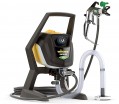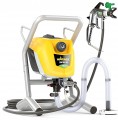The type of spray system used in the device. Different spray systems differ in the format of work and, as a result, in individual practical nuances of use:
—
HP (High Pressure) / CONV (conventional). One of the most famous and popular spray systems. The air pressure at the inlet and outlet of such spray guns is approximately the same. The advantages of HP systems are the simplicity of design, large working width, high paint application speed and relatively low air consumption. At the same time, the percentage of paint transfer in such sprayers is very low — more than half of the applied material bounces off the surface due to high speed and settles on surrounding objects. Another disadvantage is that the flow from the HP atomizer picks up fine dust and other "flying debris" heavily; because of this, additional grinding and polishing of the painted surface is often required.
—
RP (Reduced Pressure). Modification of conventional (HP) atomizers, characterized by a slightly reduced outlet pressure. This allowed for some improvement in the transfer coefficient and reduced debris levels while maintaining the advantages of good performance, uniformity and low air consumption. Nevertheless, according to these indicators, such devices are still inferior to low-pressure models.
—
HVLP (High Volume Low Pressure). Spray system with reduced outlet pressure (a
...pprox. 0.7 bar) and large air volumes. One of the key advantages of such devices is a high ink transfer coefficient of at least 65%. In addition, the low speed of the paint supply reduces the level of debris: there are relatively few turbulences that “pull” debris along with them. The main disadvantage of HVLP systems can be called high air consumption; not every compressor can handle such an atomizer. In addition, they require additional filters to protect against oil and moisture entering the air during high compressor loads; and you can work with such a device only at a short distance (usually up to 15 cm), and in order to avoid drips, a certain skill is required.
— HVLP-II (New High Volume Low Pressure). The second generation of HVLP (see the relevant paragraph), which has a number of improvements compared to the original, but is generally similar.
— LVLP (Low Volume Low Pressure) / Trans-Tech. Spray systems developed as an improvement to HVLP. With the same advantages (high transfer coefficient, minimum debris), they consume much less air and have softer requirements for compressors and hoses. In addition, LVLP systems are less sensitive to pressure drops, and the effective spraying range in them reaches 25 – 30 cm. Of the notable disadvantages of this option, one can only mention a rather high cost.
— HVMP (High Volume Middle Pressure). Spray systems with high air flow and medium outlet pressure. Compared to HVLP, due to the higher pressure, they give a slightly lower ink transfer efficiency, but greater uniformity and range.
— LVMP (Low Volume Middle Pressure). Spray systems with low air consumption and medium pressure; a kind of modification of LVLP, characterized by higher pressure. Due to this, the cost is somewhat reduced, productivity, uniformity of application and capture width are increased; however, paint consumption is higher and the finished surface is rougher than original LVLP.
— HTE (High Transfer Efficiency). This marking is used in spray systems for which a high transfer coefficient is claimed by the manufacturers. In terms of characteristics, they are most often similar to LVLPs (see the relevant paragraph) — in particular, they have a rather large effective range. However, specific features in each case should be clarified separately.
— EA (Excellent Atomization). The main feature of such systems, in accordance with the name, is a very high degree of atomization of the material. Other performance characteristics in such systems may be different, these points should be clarified separately.
— HEA (High Efficiency Airless). Proprietary airless spray technology (see "Spray") used in the Wagner brand technique. Reduces paint wastage by more than 50% compared to more traditional systems, as well as more even material distribution, according to the creators. Suitable for water and oil based coatings.
MP (Middle Pressure). Transitional option between the HP and RP described above: it provides a slightly lower working pressure compared to HP, but not as low as in RP. For a number of reasons, it did not receive distribution.
HD (Heavy Duty). A marketing designation used on individual sprayers, typically high-capacity, high-volume sprayers. The specific characteristics of such systems should be clarified separately.
